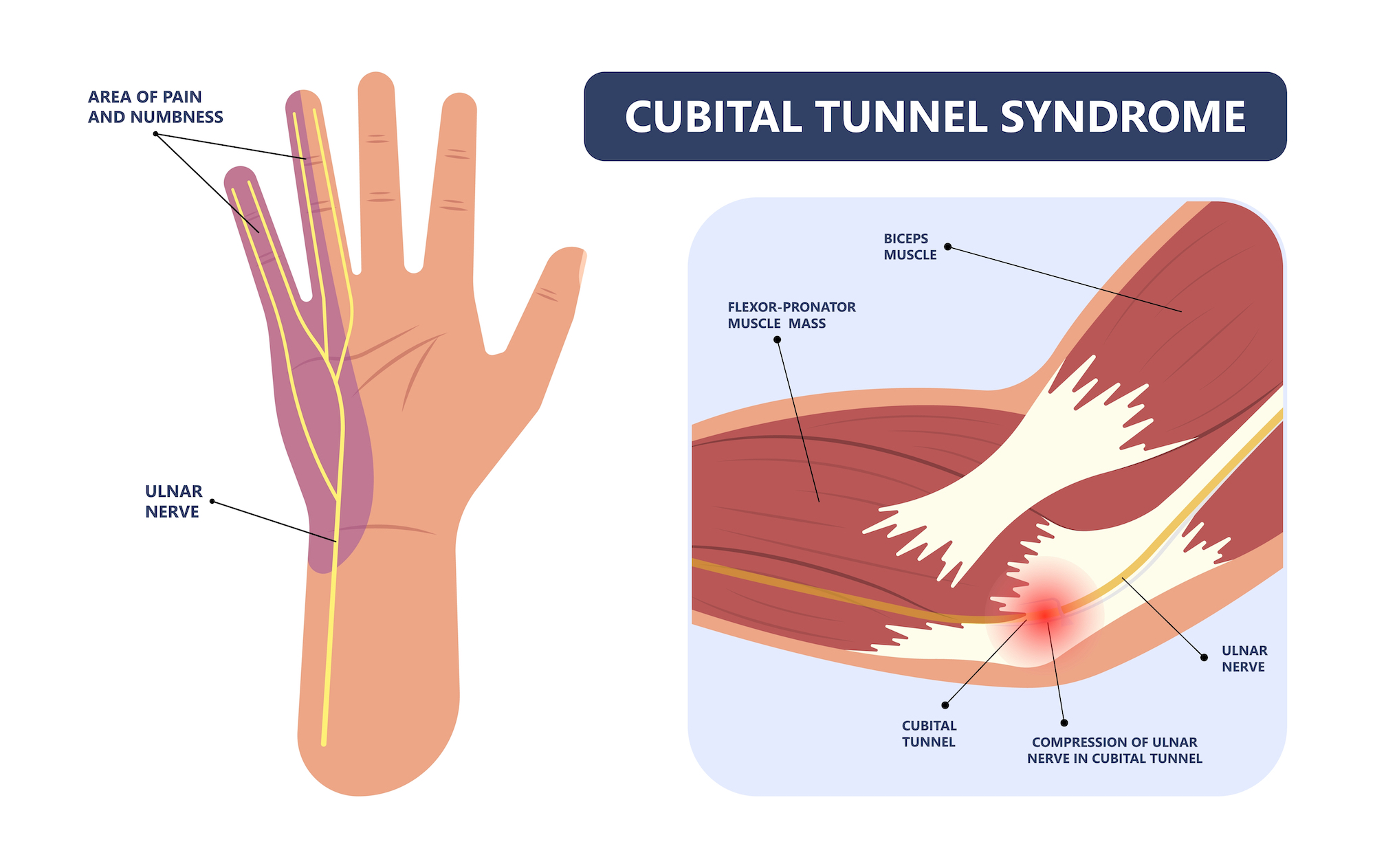Cubital tunnel syndrome is experienced as numbness or tingling in the ring finger and pinky, and can also be associated with hand weakness that can impair function. It occurs when the ulnar nerve (also referred to as the funny bone nerve) passes through a groove between two bones and a ligament on the inside of the elbow.
The nerve can become compressed under the ligament that holds the ulnar nerve in place to protect it and keep it from snapping as the elbow moves. This compression can create inflammation, and potentially cause the nerve to not function properly which can lead to numbness and tingling in the ring and small finger.
It is very important for patients experiencing symptoms of cubital tunnel syndrome to promptly get diagnosed and treated by a professional.

What Causes Cubital Tunnel Syndrome?
Cubital tunnel syndrome can occur in people who perform a lot of repetitive motion with pulling, reaching, lifting, and bending of the elbow. It occurs with frequent leaning on the elbow, and can also occur in the setting of prior trauma or injury, and with the presence of arthritis or bone spurs as all of these factors can cause compression of the ulnar nerve.
How to Test for Cubital Tunnel?
If cubital tunnel is suspected, an electromyogram (EMG) and a nerve conduction study are commonly performed to confirm the diagnosis as well as to determine the severity of compression.
How to Treat Cubital Tunnel Syndrome?
Treatment for cubital tunnel depends on the severity of symptoms and degree of nerve compression. For early symptoms and disease, non-operative treatment in the form of splinting, activity modifications, and limited use of cortisone injections are an option.
For more advanced cubital tunnel, surgery is the only definitive method of treatment.
Surgery for cubital tunnel syndrome involves creating an incision on the inside part of the elbow and releasing the ligament that compresses the ulnar nerve.
How Long Does Cubital Tunnel Syndrome Last, and Can It Go Away on Its Own?
The unique circumstances in which cubital tunnel could potentially improve on its own are when it is associated with direct trauma to the elbow. This would cause acute onset of numbness and tingling in the hand due to swelling from trauma at the elbow.
For cubital tunnel syndrome that is not associated with acute trauma, the symptoms do not spontaneously resolve and can progress over a period of time if left untreated.
Can Carpal Tunnel and Cubital Tunnel Occur at the Same Time?
Yes. It is common for patients to experience both carpal tunnel and cubital tunnel simultaneously as the same provocative activities that cause one are likely to cause the other.
Additionally, other risk factors such as diabetes and inflammatory conditions can put patients at risk for both carpal tunnel and cubital tunnel syndrome.
Can You Get Cubital Tunnel in Both Arms?
Yes, cubital tunnel syndrome can occur in both arms simultaneously.
Can Cubital Tunnel Syndrome Cause Pain in the Shoulder?
Yes, it is possible for cubital tunnel syndrome to cause referred shoulder pain.
A specialist would work to determine if the pain is emanating from the hand and elbow and radiating up to the shoulder, versus starting at the neck and radiating down to the shoulder. This assessment can help pinpoint if the shoulder pain is associated with cubital tunnel syndrome or with other central nerve abnormalities.

